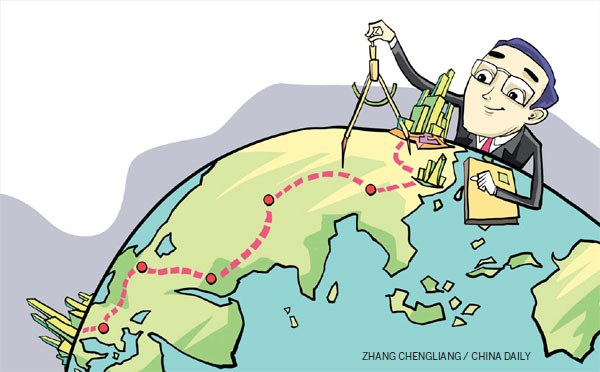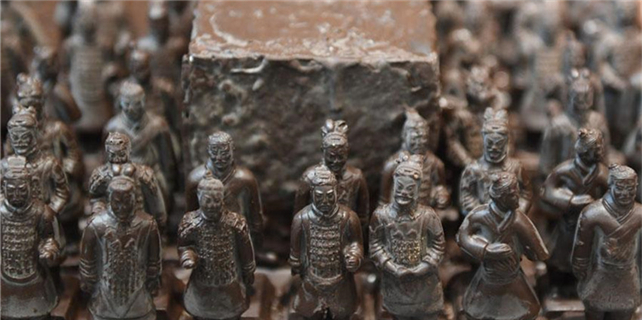Is this the road to a more stable future?
In September 2013, President Xi Jinping formally announced the Silk Road Economic Belt in Kazakhstan, and in February 2014 he expanded the program to include maritime trade. The Belt and Road Initiative, an combination of overland and a maritime corridors, will connect eastern China to western Europe and provide a platform that will stimulate economic, trade and cultural interactions.
The Asian Infrastructure Investment Bank, launched in Beijing in June 2015, is another important initiative aimed at reinforcing China's role in global affairs.
The Belt and Road Initiative and AIIB constitute two ambitious initiatives, both of which play an important role in China's foreign policy strategy for economic, trade and strategic outreach to China's partners.

In our interconnected world, the links between economics, trade and security are extremely important. The economic and trade logic is expected to help overcome obstacles and hesitations linked to security that have stalled similar projects before. Trade and economics increase the level of transactions between countries, enhance familiarity between people and discourage conflict.
It is important to note that China's strategy of security and economics creates a dense network of relations that bring assurances of security which will particularly increase influence in Asia and Europe. Economic development may address the roots of conflict in Pakistan, Afghanistan and China's western frontiers.
Unlike most other countries, China has substantial foreign reserves for large-scale projects. This enables it to ensure that countries along the corridors share an interest in participating in the ownership of the initiative, since their companies will participate in the building of the infrastructure. Many countries along the Belt and Road lack the resources to set up competing business and trade networks, so they have no choice but to participate in those sectors that might improve their connectivity to major markets and resource supplies.
The Belt and Road Initiative has been welcomed by more than 60 countries, and is of particular interest to Pakistan and India. The China-Pakistan corridor is important because the harbor of Gwadar is one of the points where overland and maritime routes intersect. The Bangladesh-China-India-Myanmar economic corridor connecting Yunnan in southern China with Myanmar, Bangladesh and eastern India is of importance to India.
With regard to other geopolitical concerns it remains to be seen how much the initiative will converge or compete with Russia's Euroasian Economic Union initiative.
The EU matters for the Belt and Road Initiative, and the Belt and Road Initiative matters to the EU.
The European dimension of the project is an integral element of the initiative. During the June 2015 EU-China Summit, both parties decided to build synergies between the Belt and Road Initiative and European Commission President Jean-Claude Juncker's investment plan, and to actively explore business and investment opportunities. There are carefully selected nodal points along the land corridor and transit and terminal points along the maritime corridor in Europe.
The EU has demonstrated that it is willing to go beyond short-term economic gains to attract China's direct investment and play an important role in turning the Belt and Road Initiative into reality. The European Investment Bank has set up a group comprising the initiative, the European Commission and the European Investment Bank to coordinate and help accelerate the implementation of projects. China is also using Juncker's investment plan to boost involvement in Europe.
Greece has been placed on the map as the end point of the maritime corridor. Cosco operates two container terminals and manages 67 percent of the port of Piraeus, which now serves as a major logistics hub for China's trade with Europe. Cosco took over TrainOSE, the Greek railway company that already signed agreements for freight transport to Central and Northern Europe with Hewlett Packard, Sony, Huawei and ZTE.
A high-speed rail corridor is envisioned to connect the port of Piraeus with Northern and Central Europe. All these agreements will reinforce Cosco's cooperation with the largely global Greek shipping industry. It should be noted that most ships for the Greek merchant fleet are built in China.
Another terminus on the maritime belt is the port of Rotterdam, an important cargo hub for Europe where land and maritime corridors come together. Hungary is also a key logistical hub on the trans-Siberian link, which serves as a distribution point for Chinese exports to Europe.
In addition to physical infrastructure, China wishes to rely on Europe for the financial integration needed for effective implementation. The EU's contribution is needed for a sophisticated financial network to underpin the physical infrastructure that will bind Europe and Asia together.
As of the end of 2015, more than 1,400 contracts were announced for infrastructure and other projects alongside Belt and Road areas. There are ongoing discussions at bilateral, multilateral and regional levels on how to accelerate the implementation of the Belt and Road Initiative through concrete projects.
In 1993 the EU launched the Transport Corridor Europe Caucasus Asia, a project similar to the China's initiative. EU technical assistance has been used to develop a transport corridor on an East-West axis from Europe across the Black Sea, through the Caucasus and the Caspian Sea to Central Asia. Ongoing projects cover transport and network operability, logistics and transport safety and security.
In a nutshell, the Belt and Road Initiative, with its continental and maritime dimensions, will enable China to assume its responsibilities on the world stage more fully as a global power. The initiative could have an important impact on China's domestic economy through export of its excess steel, cement and aluminium. In addition to the economic/trade objectives the Belt and Road has a security dimension, especially where energy is concerned.
Although it offers opportunities to boost trade and investment in the regions it covers, it also presents challenges due to uncertain political and regulatory conditions. The project passes through conflict-ridden geographical areas and countries with weak administrative structures.
For many countries along the Belt and Road Initiative, transparency, accountability and good governance are not priorities. Their poor credibility regarding security, government effectiveness, tax policies and low standards of local infrastructure, may hinder China's plans for effective implementation of the project. The critical challenge is to turn good intentions in agreements reached at the top tier of government, into real cooperation at the local level where implementation usually takes place.
China hopes that the economic development along the corridor will also help reduce tensions between the various Muslim minorities and the rest of the Chinese population. There is no doubt that through the Belt and Road, China is defining a broad geopolitical approach for future investment and trade that will affect the selection of future infrastructure projects. China's important involvement in the development of global supply chains may provide the impetus for new regional frameworks and rules.
It remains to be seen to what extent the Belt and Road Initiative's regional impact will lead to new rules of global governance now that multilateral efforts at the World Trade Organization and other United Nations multilateral forums have been stalled.
The author, former counselor at the European Commission, is currently working as a consultant in international economic and political negotiations.
The views do not necessarily reflect those of China Daily.
(China Daily European Weekly 12/16/2016 page12)


















